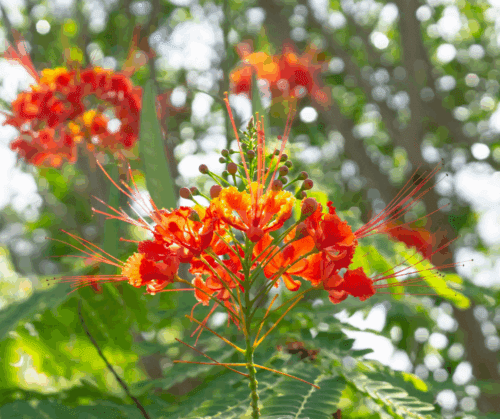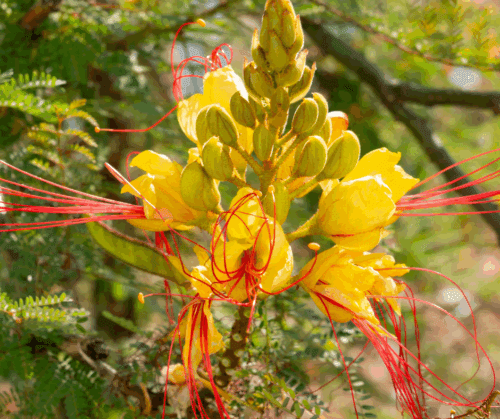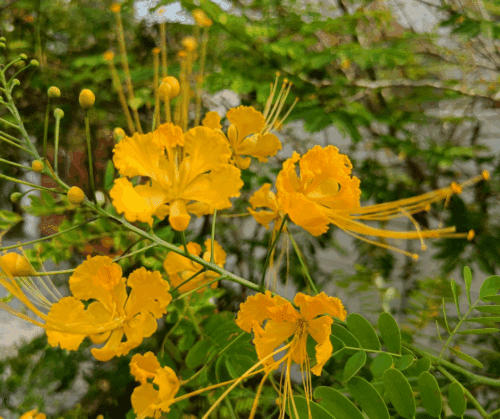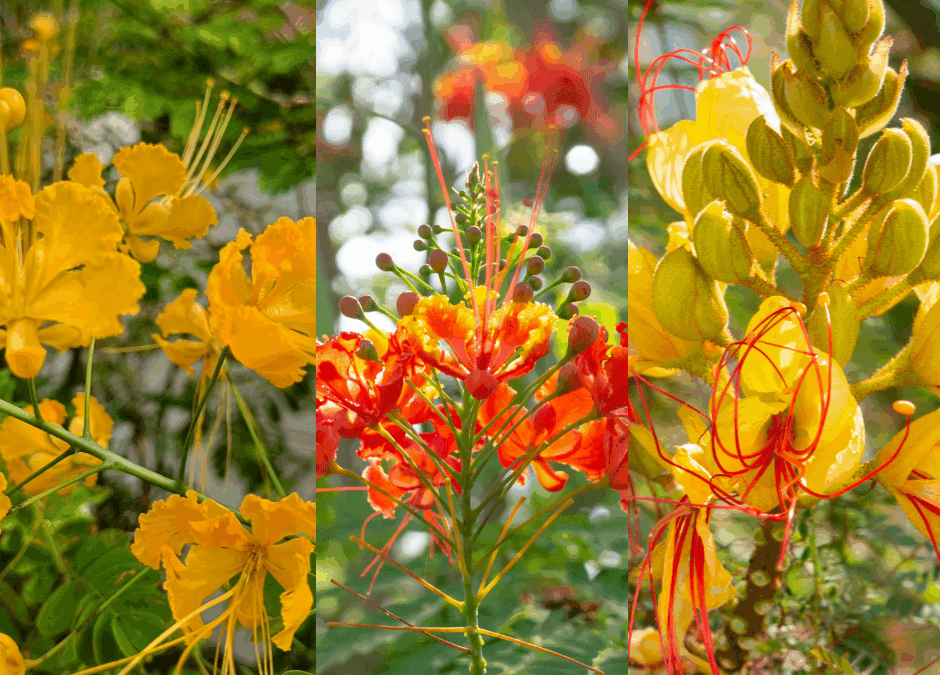If your gardens are lacking pizzazz, color, and drama, don’t worry, we’ve got just the plants to bring the heat! Meet our chosen selections of Pride of Barbados varieties, and get ready for these bold and blooming beauties to turn your San Antonio landscape into a pollinator paradise with hardly any water fuss.
Did you know there’s more than one kind of Pride of Barbados? Today we’re talking about 3 outstanding varietes: Caesalpinia pulcherrima, Caesalpinia gilliesii, and Caesalpinia mexicana. Let’s break down their differences, similarities, and why they deserve a VIP spot in your San Antonio, Texas landscape.

The Original Showstopper: Caesalpinia pulcherrima
Also known as Pride of Barbados, this flame-colored wonder is the queen bee of the trio. It flaunts fiery orange-red blooms with sunshine-yellow edges, blooming from early summer through fall.
San Antonio gardeners love it because:
-
It’s heat-loving and drought-tolerant once established.
-
Blooms attract butterflies and hummingbirds like a magnet.
-
It thrives in poor, well-draining soil with minimal fuss.
- Is deer resistant with little to no true pest or disease issues.
Growth Habit:
Caesalpinia pulcherrima grows as a large shrub or small tree, typically reaching 5–8′ tall and 4-6′ wide, all within one growing season, and even after dying back in the winter.
Cold Tolerance:
While it may die back in a hard freeze, it usually returns from the roots in late spring to early summer in USDA Zones 8–11. San Antonio now sits in Zone 9a, making our area a perfect range for this showy perennial.
Out of all the Pride of Barbados varieties, this one is the most popular in our area. Sometimes we have a pink version available!

The Elegant Cousin: Caesalpinia gilliesii
Often called Desert Bird of Paradise, Caesalpinia gilliesii is the funky cousin of Caesalpinia pulcherrima, with lemon-yellow flowers and showy red stamens that dance in the wind like feather boas.
Why San Antonio should swipe right on this variety:
-
It’s ultra heat- and drought-tolerant, just like pulcherrima.
-
It features a more wispy, airy structure—great for breezy cottage-style gardens.
-
It thrives in similar conditions: full sun, low water, and excellent drainage.
- Exotic looking.
Growth Habit:
A bit leggier and more airy than its cousin, this one can reach 6–10 feet tall and 4-6′ wide with a looser growth habit.
Cold Tolerance:
Slightly hardier than pulcherrima—it can survive colder dips and is deciduous in San Antonio but reliably returns in spring. Keep in mind that all these Pride of Barbados varieties are late starters in spring. They really need the warm temps to wake them from their slumber.
Pollinators:
Hummingbirds and butterflies adore it, and bees join the party too.

Caesalpinia mexicana: Sunshine Yellow
Caesalpinia mexicana, or Mexican Bird of Paradise, is native to Mexico and brings elegance and environmental value to the table.
Why San Antonio gardeners should be bragging about this Pride of Barbados variety:
-
No thorns!
-
Solid yellow flowers bloom throughout the warm season and attract local pollinators.
-
It has the most tree-like form of the trio—less wild, more refined.
Growth Habit:
Can grow up to 20′ – 30′ tall in the valley, but generally tops out much smaller at 10 – 15′ tall x 4 – 6′ wide, and can be shaped into a small ornamental tree. It’s evergreen in mild winters but usually freezes to the ground every 2 – 3 years in our area, returning in late spring.
Water Use & Soil:
Like the others, Caesalpinia mexicana prefers full sun, low water, and well-drained soil. It laughs in the face of San Antonio summers.
Cold Tolerance:
Winter hardy to 10-15°F without damage.
4 Reasons San Antonio Gardeners Should Grow These Plants
Living in San Antonio means one thing: HOT, dry summers. And that’s exactly why Pride of Barbados varieties are a must-have.
- Low water needs (perfect for water-wise gardening)
- Thrives in poor soils
- Attracts pollinators galore (and let’s be honest—who doesn’t want a garden full of fluttering wings?)
- Tropical flair without tropical maintenance
- Virtually pest and disease free
4 Quick Tips for Growing Pride of Barbados Varieties
Sun is your best friend – all three varieties crave full sun exposure (6+ hours daily).
Water to establish – then cut back. These plants prefer to be neglected!
Prune in late winter or early spring to shape or remove freeze damage.
Mulch to retain moisture, but don’t overdo it—remember, they like their roots on the drier side, but a little mulch protection in winter is good.
Whichever beauty you choose from of our Pride of Barbados varieties, you’ll be bringing in a showtopping bloom display that lasts through the brutal summer temps, when many other perennials are starting to look worse for the wear from the heat’s beat down.
~The Happy Gardener, Lisa Mulroy


Caesalpinia pulcherrima has been performing well in my front yard, along with Esperanza, and Desert Willow.
Elizabeth, WOW! Everything looks so great. Thanks for sending the picture!